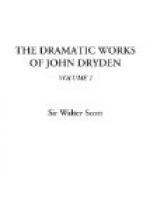“Diamond-buckles sparkling in their shoes.”
By a yet more unfortunate adaptation of modern technical phraseology, the simple direction of Helenus,
“Laeva tibi tellus, et longo
laeva pelantur
AEquora circuitu: dextrum fage lillus
et undas,”
is translated,
“Tack to the larboard, and stand
off to sea,
Veer starboard sea and land:”
—a counsel which, I shrewdly suspect, would have been unintelligible, not only to Palinurus, but to the best pilot in the British navy.[22] In the same tone, but with more intelligibility, if not felicity, Dryden translates palatia coeli in Ovid, the Louvre of the sky; and, in the version of the first book of Homer, talks of the court of Jupiter in the phrases used at that of Whitehall. These expressions, proper to modern manners, often produce an unfortunate confusion between the age in which the scene is laid, and the date of the translation. No judicious poet is willing to break the interest of a tale of ancient times, by allusions peculiar to his own period: but when the translator, instead of identifying himself as closely as possible with the original author, pretends to such liberty, he removes us a third step from the time of action, and so confounds the manners of no less than three distinct eras,—that in which the scene is laid, that in which the poem was written, and that, finally, in which the translation was executed. There are passages in Dryden’s AEneid, which, in the revolution of a few pages, transport our ideas from the time of Troy’s siege to that of the court of Augustus, and thence downward to the reign of William the Third of Britain.
It must be owned, at the same time, that when the translator places before you, not the exact words, but the image of the original, as the classic author would probably have himself expressed it in English, the licence, when moderately employed, has an infinite charm for those readers for whose use translations are properly written. Pope’s Homer and Dryden’s Virgil can never indeed give exquisite satisfaction to scholars, accustomed to study the Greek and Latin originals. The minds of such readers have acquired a classic tone; and not merely the ideas and poetical imagery, but the manners and habits of the actors, have become intimately familiar to them. They will not, therefore, be satisfied with any translation in which these are violated, whether




